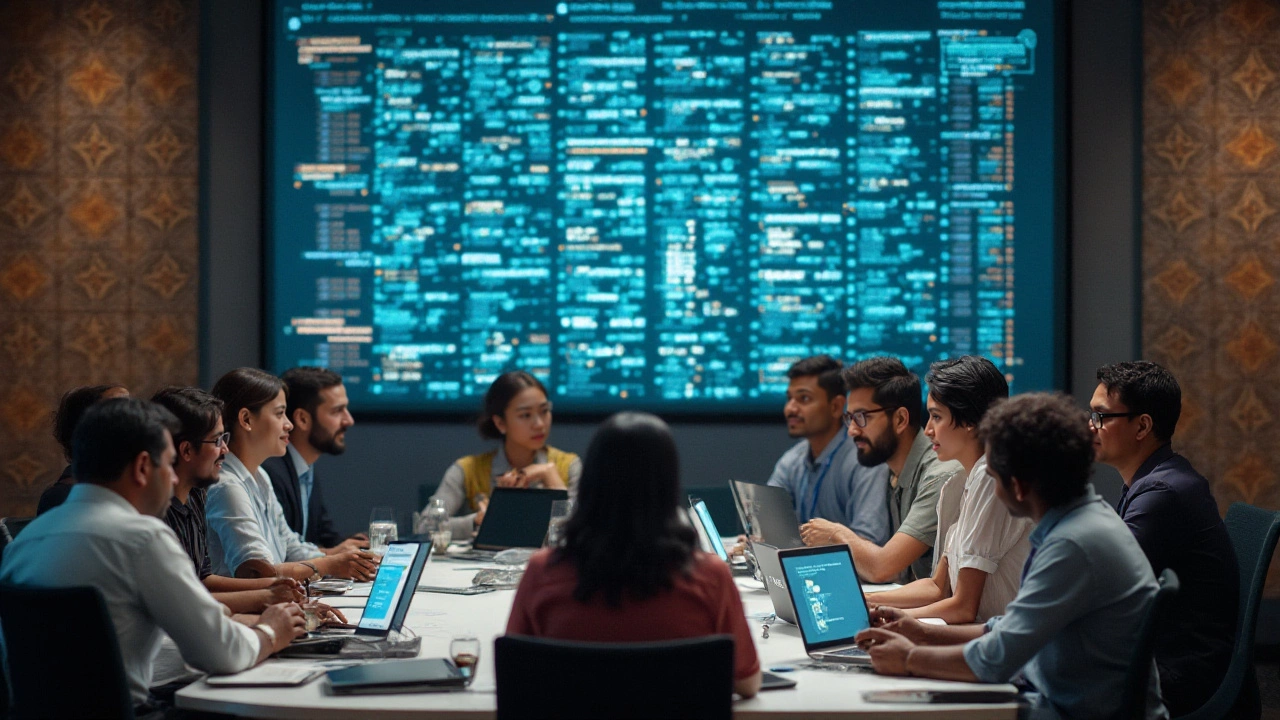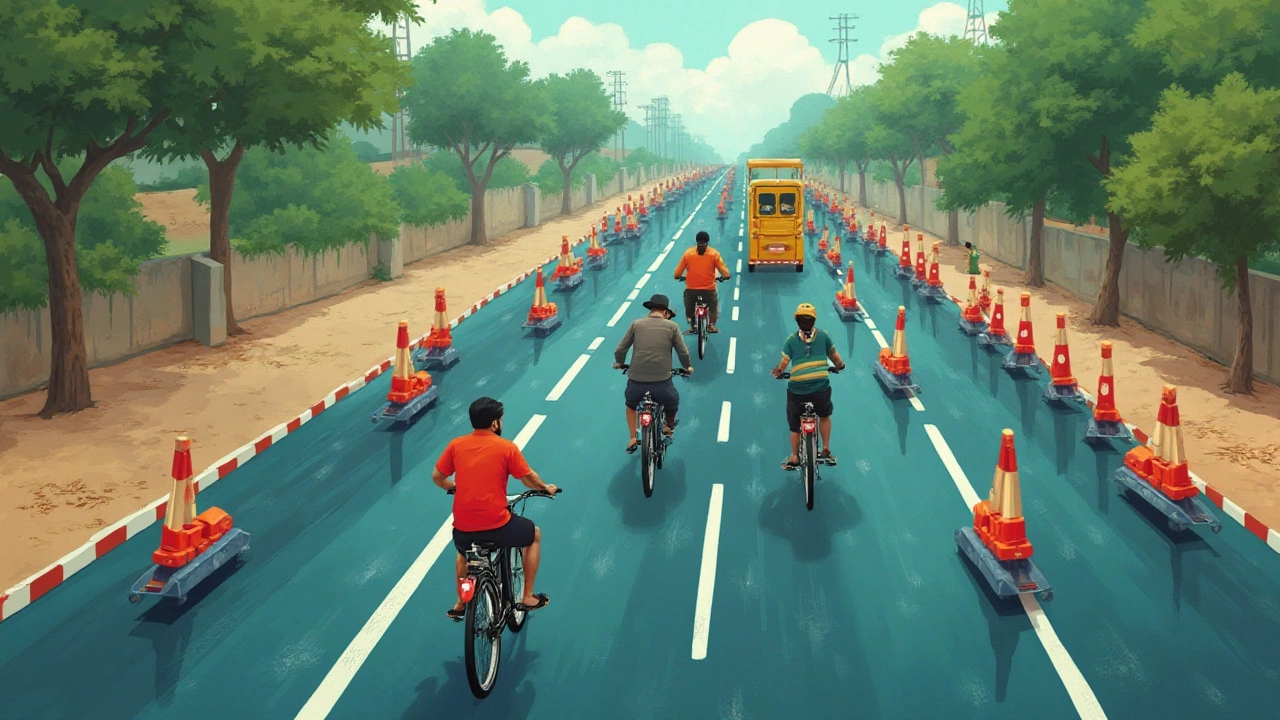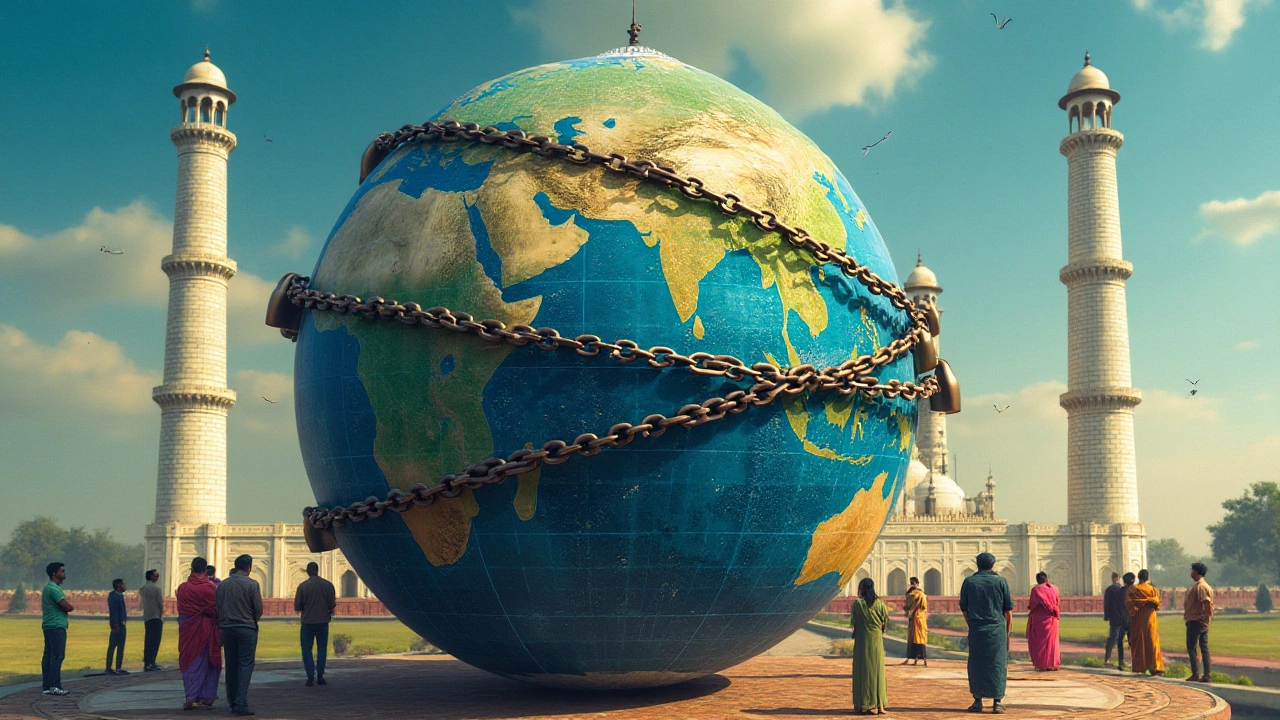With the digital landscape ever-evolving, understanding the complexities of domain blocking in India becomes increasingly important. As the country strides forward in technological advancement, certain domains find themselves restricted. The reasons behind these restrictions vary, often involving legal, cultural, or security concerns.
Diving into this topic reveals a tapestry of legal measures and cultural values that shape India's cyberspace. By comprehending these dynamics, businesses and users can better navigate the intricacies of accessing and hosting websites in a country where internet regulations are as diverse as its culture.
- Introduction to Domain Blocking in India
- Reasons for Domain Restrictions
- Types of Content Blocked
- Impacts on Businesses and Users
- Navigating the Challenges
Introduction to Domain Blocking in India
When one looks at the sprawling tapestry of India's internet landscape, it's clear that domain blocking is a significant part of the story. With a population surpassing 1.4 billion, India is home to one of the world's largest numbers of internet users, making the website restrictions here particularly impactful. Governmental bodies, primarily the Department of Telecommunications (DoT) and the Ministry of Electronics and Information Technology (MeitY), play pivotal roles in deciding which websites are accessible. Most of these restrictions intend to safeguard national security, prevent the dissemination of illegal content, or protect public morale, though debates about freedom of speech and digital rights continue to echo through the country's vibrant democracy.
The origins of India's stringent domain controls can be traced back to the early 2000s when the rise of internet accessibility started reflecting societal changes at an unparalleled pace. Around this time, concerns over digital safety became a priority. Notably, legislation such as the Information Technology Act of 2000 laid the groundwork for many of today's policies. These were designed to oversee both cyber activities and the domains through which information proliferates. Today, internet censorship in India spans various categories from gambling, pornography, defamation to incidences perceived as threats to sovereignty, often triggering blocks on countless domains.
While some scholars argue these steps are necessary for preserving cultural values, others worry about the opaque processes involved in these restrictions. In numerous reviews by digital rights advocacy groups, like the Internet Freedom Foundation, they claim a lack of transparency in how domains are systematically blocked. According to a report by Internet Freedom Foundation, “India has blocked over 4,000 websites a year on average from 2016 to 2019 without public disclosure on the evaluative criteria used.”
As Nikhil Pahwa, a respected digital rights activist in India, aptly remarked, "While protection is important, blanket bans on domains often hastily categorized pose a larger risk to free expression."Parliamentary discussions on this subject have underscored the importance of balancing national safety with personal freedoms, a challenging feat given the diverse opinions represented across the nation.
The motive behind internet censorship stretches beyond the boundaries of morality and often enters into the realm of political narrative management. Different forms of prohibited content reflect a society steeped in diverse beliefs and political underpinnings. The “blocked domains India” list evolves constantly, driven by both public pressures and political agendas. This dynamic often means rapid changes in what can or cannot be viewed online and poses a continuous adaptation challenge for both users and hosted websites. Understanding the twists and turns of these seemingly contradictory but intentionally structured restrictions offers an intriguing insight into India's technological journey and ensures that businesses operating within or with India are prepared to face the unexpected.
Reasons for Domain Restrictions
Understanding why certain domains are blocked in India requires a deep dive into the country's regulatory landscape. At the core of many restrictions is the Information Technology Act of 2000, which empowers the government to block content to ensure security, sovereignty, and public order. Under this act, emergency measures might be enacted to block access to domains deemed a threat to national security. This preemptive approach aligns with many international standards, though its implementation can sometimes stir debates about the balance between security and freedom.
A significant aspect of domain blocking stems from the cultural values deeply embedded in Indian society. Websites showcasing content that contravenes these values, such as adult content or gambling sites, often find themselves swiftly blocked. The government monitors and restricts access to anything that might stand in opposition to the traditionally held values that many Indians cherish. This approach reflects an intention to uphold societal norms in the digital world, much as they are in real life, though it does sometimes lead to controversial discourse about censorship versus moral preservation.
Economic reasons also play a role in the restriction of internet domains. For instance, domains that link to piracy or unauthorized streaming services often face blacklisting to protect intellectual property rights and the interests of local industries. This measure helps shield Bollywood's vast cinematic output and the burgeoning local music scene from the financial damage inflicted by piracy. By taking such actions, India strives to maintain a vibrant and thriving creative sector vital to its cultural economy.
"A vibrant media and entertainment industry is key to a robust national identity," said a spokesperson from the Telecom Regulatory Authority of India. "Blocking domains that infringe on these values safeguards our cultural heritage and economic interests."
Lastly, political considerations form an undercurrent in the domain restriction strategy in India. During periods of heightened political sensitivity or unrest, domains that may incite violence or spread misinformation come under scrutiny. With social media and independent websites having the power to influence public opinion significantly, the government often takes preemptive action to curtail misinformation. This approach, while protective, does invite criticism on the grounds of limiting freedom of expression and raises questions about the extent and efficacy of state control over the digital realm. These nuanced reasons for domain blocking illustrate a complex dance between control and freedom, security and openness, in India's burgeoning digital landscape.

Types of Content Blocked
In India, the process of blocking domains often revolves around specific content categories that clash with national laws or cultural norms. Understanding these categories is vital to grasp why certain websites might be inaccessible within the country. One prominent category is adult content, which is strictly regulated and blocked as a measure to uphold public decency. The Indian government has continuously taken steps to prevent access to such material, citing moral and social reasons. Internet censorship in this regard aims to promote safe and acceptable online behavior, particularly in protecting young audiences.
Another major area of concern involves websites promoting hate speech or content that can incite violence. In the past, numerous domains that posted inflammatory content, intended to disturb public harmony or spread misinformation have found themselves on the blocked list. The regulatory focus on blocking such content emphasizes India's commitment to maintaining social peace and security. In a notable instance, during communal tensions, several social media pages were restricted to curb the spread of incendiary messages, effectively demonstrating the need for such measures.
Websites that divulge unauthorized or pirated material also face stringent blocks. This includes platforms that offer pirated movies, music, or software downloads, which infringe on intellectual property rights. The government, aiming to protect the creative industry and uphold copyright laws, regularly cracks down on these sites. It collaborates with industry stakeholders to ensure that takedowns are effective and fair. Website restrictions in this domain have been bolstered by international treaties, reflecting a global consensus on combating piracy.
Besides, various domains may be blocked due to legal prohibitions on specific political content. When certain sites present content seen as politically sensitive or undermining national security, they encounter blocks. This action is often taken in line with security assessments concerning the potential impact of the information shared. The contentious nature of political discourse online makes this a continually monitored and adjusted category. Critics often debate the fine line between national security and the freedom of speech, making this a complex facet of India's internet censorship policies.
Interestingly, many users find innovative ways to bypass these blocks, leading to a continuous game of cat-and-mouse between regulators and tech-savvy residents. As digital literacy improves, so does the need for more sophisticated filtering technologies. As one Indian journalist notably commented,
"In a country as vast and diverse as India, regulating content is akin to painting a constantly moving canvas."This dynamic nature of digital restrictions suggests that the landscape will continue to evolve, demanding vigilance and adaptability from both users and regulators alike.
Impacts on Businesses and Users
When it comes to domain blocking in India, the repercussions for businesses and users are multifaceted and often significant. For businesses, especially those concerned with website hosting or e-commerce, access to the digital realm is crucial. The imposition of restrictions can abruptly cut off critical connections with Indian consumers or disrupt supply chains reliant on international cooperation. Companies might find themselves grappling with a sudden loss of visibility or an unexpected dip in consumer trust, impacting their revenue streams and threatening long-term growth strategies.
In contrast, ordinary users experience these restrictions in their own ways. India's burgeoning youth population, deeply engaged with digital ecosystems for everything from education to social interaction, often finds itself at a crossroads. The sudden unavailability of certain websites can hamper academic research, limit employment opportunities, or sever lines of communication, affecting both personal and professional lives. Access to information becomes a commodity not easily available, potentially fostering environments where misinformation can thrive unchallenged.
The Economic Repercussions
Economic impacts are just as pronounced as the cultural and social ones. Companies may need to invest significantly in infrastructure or reconfigure their hosting solutions to comply with local regulations, diverting resources from innovation and expansion. For instance, implementing local hosting solutions to adhere to compliance can incur unwanted costs, as hosting domestically in India might be pricier than international alternatives. Alternatively, businesses may need to allocate funds towards legal consultations and crisis management strategies, which can stall otherwise thriving operations.
An industry expert once noted, "The key to thriving in India is adaptability. Businesses must not only understand the local regulations but anticipate changes before they occur."
Moreover, entrepreneurs and smaller enterprises looking to tap into the Indian market must navigate these complexities with fewer resources than their larger counterparts. It becomes evident that understanding the landscape of blocked domains is invaluable for anyone aiming to maintain a viable presence in the region.
Social and Cultural Dynamics
Social dynamics also play a role in how these restrictions affect daily life. In a diverse country like India, where languages and cultures vary dramatically from region to region, the digital sphere acts as a unifying platform. Disruptions to this ecosystem can deepen existing divides or create new ones. For example, access to specific cultural content or news perspectives might be unevenly distributed, leading to homogenized discourse that doesn't reflect the country's rich diversity.
Therefore, while domain blocking can serve as a tool for enforcing national security or cultural integrity, it carries with it the risk of alienating the very people it seeks to protect. The challenge lies in balancing these objectives with the need for open access to the world's collective knowledge. Businesses, users, and policymakers alike are continuously negotiating these dynamics, shaping the future of India's digital landscape.

Navigating the Challenges
Dealing with blocked domains in India can be a complex task for both businesses and individuals. The first step is understanding the underlying reasons for why a domain might be blocked. This understanding can often guide one's strategy towards finding alternative means of access or even legal recourse. Whether it’s for legal, cultural, or ethical considerations, knowing the specific laws and guidelines is critical. Internet censorship varies widely across regions, and being aware of these facets helps in formulating a practical approach.
In India, the blocking of websites is primarily governed by the Information Technology Act, 2000 and its amendments. For anyone dealing with these restrictions, it’s vital to stay updated on these regulations. Routine updates are issued by the Indian Department of Telecommunications, which acts to restrict specific web content. Some domains find themselves repeatedly targeted due to copyright issues or content deemed „objectionable.” Being vigilant and proactive in understanding these terms is crucial for businesses wanting to host websites in India.
An effective way to work around these obstacles is by leveraging technological solutions. Virtual Private Networks (VPNs) have become a popular choice, allowing users to disguise their online location and access content that might be restricted locally. However, it's essential to note that the legality of VPNs is sometimes contested, and users must weigh the potential legal implications. Alternatives like using proxy servers or decentralized web infrastructure can also be considered, though each has its pros and cons.
For businesses, another key strategy is local compliance. Working with legal and security experts who understand Indian internet policies can help in avoiding unnecessary hurdles. Ensuring your website content is aligned with local laws can prevent your domain from being blocked in the first place. For example, ensuring sensitive content is tagged appropriately or restricted to specific user bases can mitigate potential issues with authorities. This is not just a matter of keeping in mind the regulations but also operating within them innovatively to minimize risk.
"In our interconnected world, finding the balance between freedom and regulation is key," says a leading cyber security expert.
It's vital that users and businesses educate themselves continuously to navigate digital landscapes that are ever-shifting.With this mindset, entities operating within India's internet spaces can adapt to changes swiftly. Updates in technology and policy will continue to shape the environment, making adaptability an essential skill.
| Year | Number of Blocked Domains |
|---|---|
| 2020 | 2500 |
| 2021 | 3000 |
| 2022 | 3500 |
For individuals, staying informed with resources like official government releases, tech forums, and online communities can equip them with the knowledge to address and potentially circumvent these challenges legally and ethically. As the landscape of internet usage continues to change rapidly, staying ahead requires a commitment to continuous learning and adaptation. This approach ensures that users don't just survive amidst restrictions, but thrive despite them, accessing the web with a sense of empowerment and awareness.
